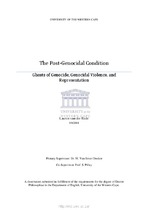| dc.description.abstract | As a literary intervention, The Post-Genocidal Condition: Ghosts of Genocide, Genocidal
Violence, and Representation is situated at the intersection of genocide studies,
psychoanalysis, and literature so as to enable a critical engagement with the question of
genocide and an attempt to think beyond its formulation as phenomenon. As the dominant
framework for thinking genocide within international jurisprudence, and operating as the
guiding terrain for interventions by scholars such as Mamood Mamdani, Linda Melvern, and
William Schabas, the presumption that genocide may be reduced to a marked beginning and
end, etched out by the limits of its bloodiness, is, I argue, incomplete and thus a misdiagnosis
of the problem, to various effects. Moreover, I contend that it is this misdiagnosis that has led
to what I name as the post-genocidal condition: a deferred return to the latent violences of
genocide; enabled often through various mechanisms of transitional justice. This intervention is not a denial that under the rubric of the crime of genocide, as an attempt
to destroy in whole or in part what Raphael Lemkin referred to as an “enemy group”, millions
of people have died. Rather what I posit is that the physical violence of genocide is a false
limit – that the bloodiness of genocide has been mistaken for the thing-in-itself. Thus this
intervention is an attempt to offer another way of thinking the question of genocide by
reading it as concept, enabling a consideration of its more latent violences, its ghosts. As
such, I argue that genocide is first an attack on the minds of the persons who form the
targeted people or group, through the destruction of cultural apparatuses, such as books,
works of art, and the language of a people, to name but a few; and is lastly an attempt to
physically exterminate a people. Thus this intervention invites a return to Lemkin’s formulation of the term in Axis Rule in Occupied Europe: Laws of Occupation, Analysis of
Government, Proposals for Redress (1944); that the word genocide is meant to “signify”, and
as such offers a reading of the question of genocide as signifier, understood, I suggest, in the
Lacanian sense. Thus, I posit that genocide, as signifier, operates on both the levels of
metaphor and metonym, and as such both condenses and displaces its violence(s). The
metaphor for genocide as signifier is, furthermore, rather than the signifying chain as Lacan
would have it, the network. As such genocide is marked as text, rather than work; its
perpetrators not authors, as Lemkin and various pieces of legislation have described them, but
writers; and those who engage with the question of genocide, to whatever degree, as readers
rather than critics. Consequently, this intervention stages the question of the reach of
impunity and complicity, beyond the limit of judicial guilt and innocence. Metonymically,
the relational displacement at work within the network of genocide allows for a reading of the
various constitutive examples of the violence(s) that, in combinations and as collective,
produce a new signification, other than that of the definitional referent. | en_US |




